It’s a sight that any horse person can appreciate: a group of horses grazing together or relaxing in a group beneath the cool shade of a tree. Horses are, after all, herd animals, so they are most at home with other horses.
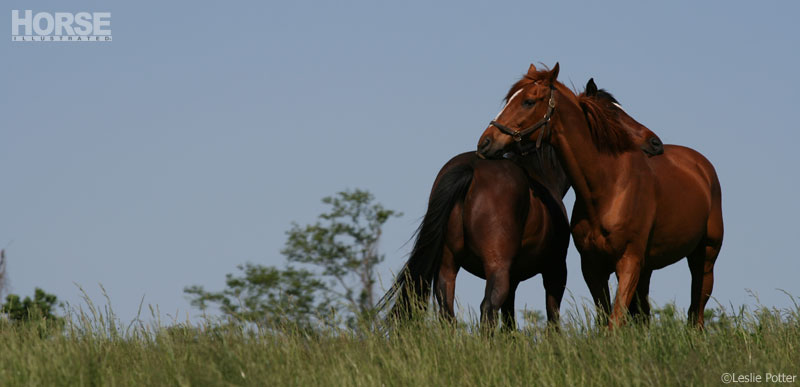
But putting horses together isn’t always easy and some—just like people—simply don’t get along. With a little common sense and good horsemanship you can turn out safely and avoid many dangerous situations.
“Bigger is always better. The larger the area, the easier horses can get out of each other’s way,” says Karen Dodd of Southern Chase Farm, a training and boarding operation near Ocala, Florida. Karen and husband Greg own and manage the 425-acre farm and regularly buy, train and sell young horses.
In any group of horses, the natural equine pecking order comes into play. There’s no 100% positive way to determine compatibility until you actually put horses together, Karen points out, but you can certainly put the odds in your favor that things will go well.
- Let horses get acquainted in stall or over fence before turning out together
- Turn out in pairs so horses buddy up
- Never turn out unfamiliar horses at night or when you can’t stay around to watch for a while
- Don’t put two dominant horses together
- Separate horses at feeding time
“We turn out in pairs. That way there are even numbers and less chance of one horse being the ‘odd one out,’” says Karen.
Before turning out horses in the same paddock or field, put them in neighboring pens or stalls so they can get familiar with each other. If they show obvious dislike or aggression, you’ll know to try a different match-up for turn out.
“We put horses that are turned out together in stalls next to each other so they’ve already met by seeing and smelling each other through slats in the stall walls,” notes Karen. “This gives you an idea how they’re going to act.”
Don’t turn colts, stallions or two dominant horses (of any sex) out together. They are likely to be too aggressive and might hurt each other or even run through a fence.
When turning horses out together for the first time, always stay close by for at least 20 to 30 minutes to see how things go. Expect squeals and snorts and don’t be surprised if the horse run a few laps around the field or paddock as they sort things out amongst themselves.
If you have doubts about how horses will react, you can always ask your veterinarian to give each a small dose of tranquilizer—just enough to “take the edge off”—a few minutes before turning them out the first time together. By the time it wears off, the horses should have settled down and will likely just drop their heads and start grazing.
Any time you have one horse that is more timid that the other(s), always turn that horse loose first. This way a more dominant horse won’t rush up and intimidate the horse you’re holding (catching you in the middle!) when you are pulling off the halter. (Likewise, when taking horses out of the field, catch the more dominant horse first.)
An important way to avoid potential dangers is not to feed hay or grain in the field. By separating horses (in pens or stalls) at feeding time, you greatly lower the chance of injury from horses kicking, biting or fussing over food. This also reduces the stress and anxiety a more timid horse endures when repeatedly getting chased away from his feed. Constant stress is a source of digestive woes and other health problems, so do whatever you can to eliminate it; separating horses at feeding time is a prime way to do this.
Remove halters when turning horses out so they can’t get them caught on something or grab them when playing.
If you have ponies, miniature horses or otherwise vulnerable equines—such as old or “gimpy” horses or with mares with young foals at side—only turn them out with similar pasture mates. For example, a full-size horse might have fun running and playing with a mini, but unintentionally injure the smaller animal with a frisky kick. Realize that an older, slower horse can’t get out of the way of younger, stronger horses and could get hurt.
Finally, remember your own safety whenever turning out. ALWAYS turn the horse to face you before releasing your hold. This allows you to step out of the way if he jumps or whirls and kicks out the moment he realizes he’s loose.
Further Reading
The Best of Outdoor Living
Pasture Maintenance

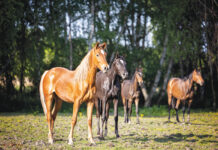
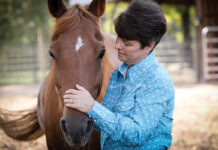
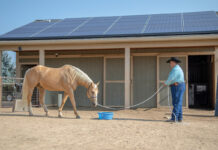
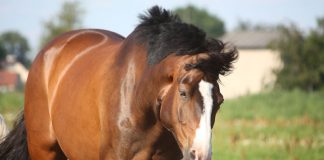

I disagree with the statement that hay should not be fed in the field. Free access hay (24/7) is the best and most natural way to feed horses. Just be sure to have several feeders (we have 3 large hay net stations for 6 geldings) and there will be no fighting, no stress plus the obvious digestive benefits and lower risk for colic.
An interesting article. My mare has been attacked in the field before, once pretty severely The last time she almost got her hocks broken as the mare was known to be aggressive and I got little sympathy from the yard owner. I changed yards after that and am now at a yard where they all seem to get on together. I’m in the UK and too many yards just expect you to shove your horse out in the field with the others the minute you get there and b*gg*r the consequences! I guess being a smaller country many yards don’t have individual turnout due to lack of land. However, horses are like humans – you can’t like everybody. My horse only gets turned out during the day and I fret every time she is out, but I know she also has to be a horse. As I said, very interesting. Thank you.
I really like this article! In the fall my horse started out being turned out with just one other horse and everything was fine. Then another horse was added to the mix and my poor horse was always found on the opposite side of the paddock from the two. When I would go to bring him in the others would go on his sides and chase him away from me. Wouldn’t even help to bring a whip in to shoo them off because one would run away and the other would come back, and so on. On the day that I was going to tell my trainer he needed to be moved, we found out that my horse tore a groin out in the paddock. While I can’t say for certain whether or not the constant bullying from the other horses is what caused him to essentially do the splits in the mud, I don’t think it helped or was a good situation for him. Now he has been on stall rest for the past 6 months and is fully recovered, but we are waiting for the ice to go away to put him back outside safely.
On another note, our barn takes out hay to the paddocks several times a day. Each horse gets their own pile spaced out from everyone else and that seems to work pretty well!
One of you comments was removing halters prior to releasing horses. Please note the horse(s) in your photo have a halter on. May be a bit picky but people often look at a photo and scan without reading properly. It is a major safty issue in the paddock
This article show very clear from where the crap (bs) come in horse industrie
1. The horse is not made to be held in stall or/and by him self. The horse is a herd animal, like we the humans are. Yes we the humans are herd animals too, we don’t call herd but we call it “society”, “trib”, “church”, “family”, and so on
2. This article show how this person(s) that wrote and approved this article don’t have knowledhe about a horse – I believe they make confusion between horse and dog, or between horse and motorcycle
3. For a horse you need 1.5 acre of pasture, for three horses you need at least 4 acres of pasture. If you cannot aford to have at least one acre per horse then you don’t aford to have a horse
Remember a horse is not a dog and neither a motorcycle or car
Go watch you tube video “Why Horses should not be fed together – Horses being horses & eating together – is a miracle” . by Think like a horse
If you want to have a horse STUDY to find what a horse is
Great advice.
I like this read. I have a 13 yr old Gelding, for 4yrs. now, and just bought a 3yr. old STALLION BUCKSKIN. My 13 yr. old, was here FIRST, and we have to TETHER the 13 yr. old when in the CORRAL? The STALLION, has just been CASTRATED on the 3rd. of July, and RECOVERING GREAT! My Vet., say’s I can Ride him, a LITTLE at a TIME. HOW, WHAT can I DO to CHANGE this 13yr old BULLISHNESS toward’s the 3yr. old? When they BOTH go out to RIDE, they are VERY CLOSE? DAH! Any Answer’s? Ty. Paula